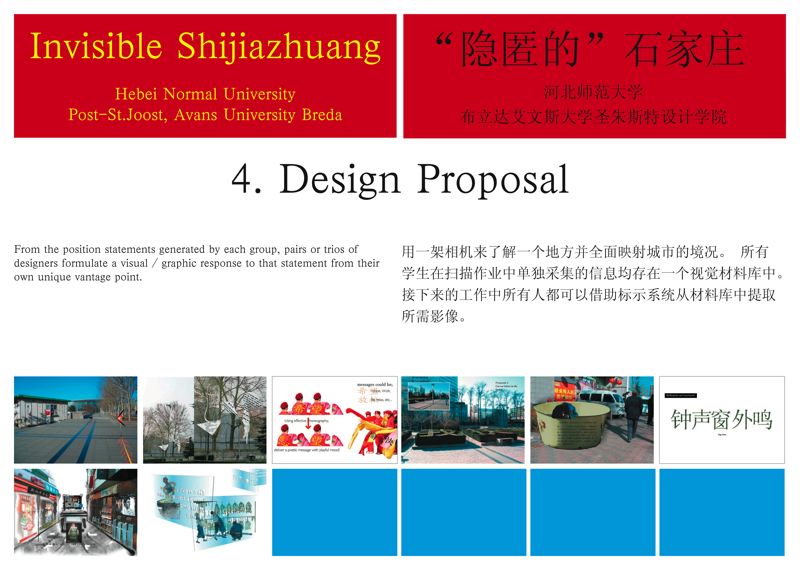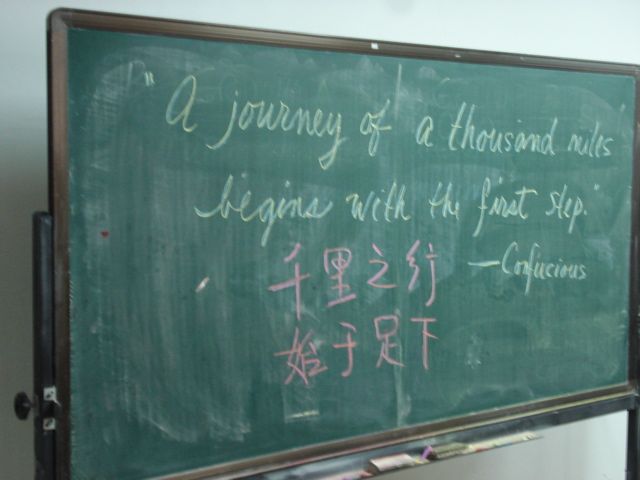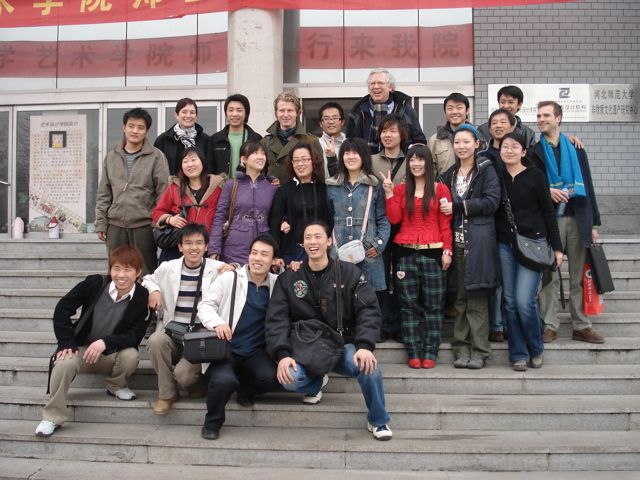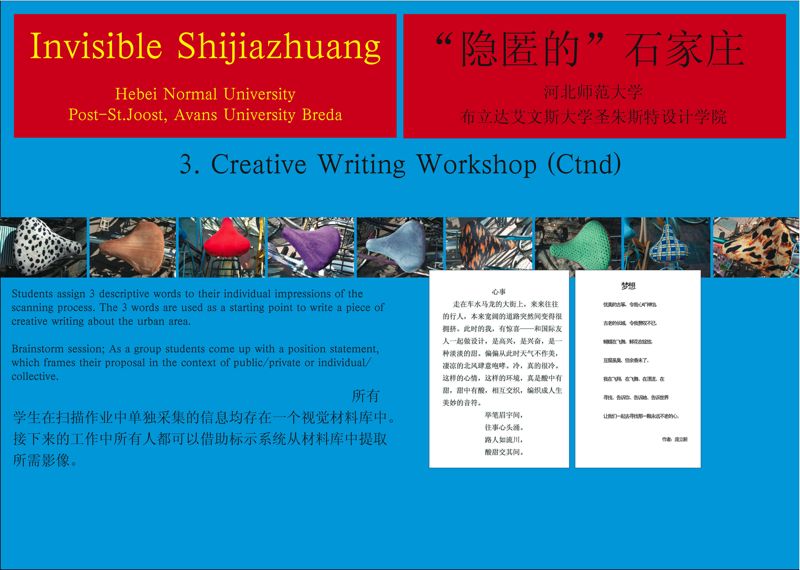Verbal/visual workshops for graphic designers and fine artists at Hebei University in Nanjing and Shijiazhuang, China, with Willem Oomens, Maarten Verweij, and Steffen Maas (Spring and Autumn 2007)
* * * * * * * * * * * * * *
Nanjing Technical University
7-8 November 2007-11-06
* * * * * * * * * * * * * *
Deer Park
by Wang Wei
from The Selected Poems of Wang Wei
translated by David Hinton
No one seen. Among empty mountains,
hints of drifting voice, faint, no more.
Entering these deep woods, late sunlight
flares on green moss again, and rises.
1. A Retelling
?Deer Park? is one of Wang Wei?s most famous poems. It is part of his Wheel-Rim River sequence.
The thinking behind Wang Wei?s poetry is that we know ourselves most absolutely in the emptiness of nonbeing, the source that endures through all change.
In Wang Wei?s poetry landscape is everything: emotion, thought, character description (principally the poet?s but applicable to Everyman).
Wang takes the poem beyond words on a page, returning [sic] consciousness to its most elemental and resounding dimensions of emptiness and landscape. Introduction, by David Hinton
This poem suggests the emptiness of today?s ?polar? communities: places without a self; there-not-there.
__consider the poet?s use of imagery and metaphor;
__how does the poem make you feel?
__in what ways do you relate to the poem?s sentiment?
__make a short list of words that you most directly associate with the poem; think broadly;
__now retell the poem in your own words, based on your own experience.
You have 45 minutes for this exercise, after which you will be asked to read your poem in class.
2. Verbal Scanning: bringing the verbal to the visual
The scanning process is essentially one of:
__seeing with your eyes;
__perceiving with your mind;
__discerning with your senses.
__think about what you?ve seen;
__assign 3 words that, in your opinion, most amply describe or frame your impressions of the scanning site;
__select words that are descriptive, vivid, specific;
__avoid words like beautiful or ugly; is there, for instance, a musical term that matches your feeling for the place? or a taste? A smell? a country?...
__the 3 words you choose should complement each other;
__avoid synonyms; remember: harmony is born of dissonance.
You have 20 minutes for this exercise, after which you will share your words with the class.
3. Between what we see and what we say
Using your 3 words as a starting point, write a short piece of writing using the scanning site as subject. The form is up to you. It can be a poem, song lyrics, a fairytale, a newspaper report, a radio broadcast script.
__consider your audience;
__consider too what you are trying to communicate; obviously your choice of 3 words indicates an opinion you have formed about the site;
__what do you want to persuade your reader to do/feel, or not to do/feel?
__your writing should be descriptive, vivid, specific, incorporating your 3 words;
__your reader should be able to ?see? what you are describing;
__likewise, your piece should touch or move your reader in some memorable way.
You have 45 minutes for this exercise, after which you will share your writing with the class.
4. Collective Conclusions
The 3 words selected by the members of your office, and the original piece of writing composed by each, taken together, form the briefing for a theme-based, site-specific intervention.
The words and writing serves as clues and sources of inspiration.
__brainstorm;
__then select 3 words from the existing list that, in your collective opinion, best represent what your office thinks/believes about the scanning site;
__these 3 words should, in effect, represent your office?s point of view;
__now formulate a position statement, which will serve as a frame of reference for your proposed intervention; MAKE IT BOLD!
You have 60 minutes for this exercise, after which you will present your statement to the class.
Be prepared to defend your position statement.
Your fellow students are expected to listen attentively and to be critical in their responses (e.g. do they agree or disagree with your assertion; why?).













Meghan Ferrill* * * * * * * * * * * * * *
Nanjing Technical University
7-8 November 2007-11-06
* * * * * * * * * * * * * *
Deer Park
by Wang Wei
from The Selected Poems of Wang Wei
translated by David Hinton
No one seen. Among empty mountains,
hints of drifting voice, faint, no more.
Entering these deep woods, late sunlight
flares on green moss again, and rises.
1. A Retelling
?Deer Park? is one of Wang Wei?s most famous poems. It is part of his Wheel-Rim River sequence.
The thinking behind Wang Wei?s poetry is that we know ourselves most absolutely in the emptiness of nonbeing, the source that endures through all change.
In Wang Wei?s poetry landscape is everything: emotion, thought, character description (principally the poet?s but applicable to Everyman).
Wang takes the poem beyond words on a page, returning [sic] consciousness to its most elemental and resounding dimensions of emptiness and landscape. Introduction, by David Hinton
This poem suggests the emptiness of today?s ?polar? communities: places without a self; there-not-there.
__consider the poet?s use of imagery and metaphor;
__how does the poem make you feel?
__in what ways do you relate to the poem?s sentiment?
__make a short list of words that you most directly associate with the poem; think broadly;
__now retell the poem in your own words, based on your own experience.
You have 45 minutes for this exercise, after which you will be asked to read your poem in class.
2. Verbal Scanning: bringing the verbal to the visual
The scanning process is essentially one of:
__seeing with your eyes;
__perceiving with your mind;
__discerning with your senses.
__think about what you?ve seen;
__assign 3 words that, in your opinion, most amply describe or frame your impressions of the scanning site;
__select words that are descriptive, vivid, specific;
__avoid words like beautiful or ugly; is there, for instance, a musical term that matches your feeling for the place? or a taste? A smell? a country?...
__the 3 words you choose should complement each other;
__avoid synonyms; remember: harmony is born of dissonance.
You have 20 minutes for this exercise, after which you will share your words with the class.
3. Between what we see and what we say
Using your 3 words as a starting point, write a short piece of writing using the scanning site as subject. The form is up to you. It can be a poem, song lyrics, a fairytale, a newspaper report, a radio broadcast script.
__consider your audience;
__consider too what you are trying to communicate; obviously your choice of 3 words indicates an opinion you have formed about the site;
__what do you want to persuade your reader to do/feel, or not to do/feel?
__your writing should be descriptive, vivid, specific, incorporating your 3 words;
__your reader should be able to ?see? what you are describing;
__likewise, your piece should touch or move your reader in some memorable way.
You have 45 minutes for this exercise, after which you will share your writing with the class.
4. Collective Conclusions
The 3 words selected by the members of your office, and the original piece of writing composed by each, taken together, form the briefing for a theme-based, site-specific intervention.
The words and writing serves as clues and sources of inspiration.
__brainstorm;
__then select 3 words from the existing list that, in your collective opinion, best represent what your office thinks/believes about the scanning site;
__these 3 words should, in effect, represent your office?s point of view;
__now formulate a position statement, which will serve as a frame of reference for your proposed intervention; MAKE IT BOLD!
You have 60 minutes for this exercise, after which you will present your statement to the class.
Be prepared to defend your position statement.
Your fellow students are expected to listen attentively and to be critical in their responses (e.g. do they agree or disagree with your assertion; why?).



























